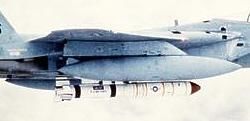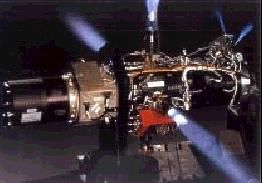
Home - Search - Browse - Alphabetic Index: 0- 1- 2- 3- 4- 5- 6- 7- 8- 9
A- B- C- D- E- F- G- H- I- J- K- L- M- N- O- P- Q- R- S- T- U- V- W- X- Y- Z
ASAT
 ASAT |
AKA: Air-Launched Miniature Vehicle;ASM-135;ASM-135A. Status: Retired 1986. First Launch: 1984-01-21. Last Launch: 1986-09-30. Number: 5 . Gross mass: 1,200 kg (2,600 lb). Height: 5.40 m (17.70 ft). Diameter: 0.46 m (1.50 ft). Apogee: 1,000 km (600 mi).
To launch the ASAT, the F-15A pilot had to fly a precise launch profile. At the calculated pull-up point, flying at Mach 1.22, he had to pull into a 3.8 G, 65 degree vertical climb. The missile would automatically release itself at 11,600 m altitude, followed by first stage ignition. After the first stage burned out and separated, the second stage propelled the Miniature Homing Vehicle (MHV) into space in a near-vertical trajectory on a collision course with the target. The second stage was equipped with a hydrazine attitude control system and spin table for the MHV. The second stage would orient the MHV toward the oncoming satellite (as determined by pre-launch orbital tracking data), spin the MHV up, and then release it. The MHV homed on the satellite, which was approaching at 8 km/second, and destroyed the target by ramming it.
Vought received the definitive contract to develop the missile in 1979, and captive flight tests with dummy vehicles hung from a modified F-15A began in 1982. The US Air Force had plans to equip 20 F-15A interceptors for launch of ASAT, and to buy 112 of the missiles. But following five tests, four of the successful, the program was officially terminated in 1988 as potentially violating international treaties. It was said that some missiles remained in active storage in case their use was needed in an emergency. It was also possible that the whole program continued but went deep black, or that the need was filled by some other deep black program. It was also possible that although superficially successful, expensive-to-surmount technical problems remained to be solved in order to field an operational system.
The MHV was developed from a Vought anti-tank design. It was spin-stabilized at 30 rpm, and used 64 small circumferential short-pulse solid-propellant rocket motors for maneuvering. A Honeywell ring laser gyroscope was used for spin rate determination, but there was no inertial platform for position or attitude determination. The vehicle simply homed onto the primary infrared target in its field of view. There was a C-band transponder for ground radar tracking. Hughes Santa Barbara developed the infrared sensor, which consisted of eight strips of infrared-sensitive material - four arranged in a cross and four spiral curves. The object's position in the focal plane was calculated using the time of detections on the various strips as the vehicle rotated. Guidance used a Direct Proportional Line of Sight algorithm to fire the motors in order to bring and keep the infrared target at the center of the detector strips.
56 of the rocket motors were full charge, and 8 were half-charge, for use in the final milliseconds of intercept. Coning of the vehicle was damped by four pods of tiny solid charges at the rear of the vehicle. The rocket propellant was a special formulation to minimize hot unburnt particles interfering with the sensitive infrared detector. However manufacture of the special propellant motors encountered difficulties with grain voids and slumping.
The seeker required cryogenic cooling by liquid helium from a large Dewar on the ground before takeoff. Another aboard the F-15A kept the seeker cool until launch. A small Dewar in the vehicle kept the seeker cold from launch to intercept. This operational constraint, and the propellant slump problems, may have created insurmountable operational issues that could have contributed to the program's cancellation.
Boost Propulsion: Solid rocket. Cruise Thrust: 27.400 kN (6,160 lbf). Cruise engine: FW-4S TEM640.
More at: ASAT.
Family: aircraft-launched, anti-satellite. Country: USA. Engines: SR75. Launch Sites: Western Test Range DZ. Stages: Altair 3, LPC-415. Agency: Vought . Bibliography: 2, 563, 4858, 4960, 8148.
 | ASAT HMV Credit: USAF Museum |
 | ASAT |
 | F-15 Launched ASAT Credit: USAF |
 | ASAT Credit: Boeing / Rocketdyne |
1979 May 31 - .
- Instrumented Test Vehicle to be used in testing anti-satellite weapons. - . Spacecraft Bus: SRAM. Spacecraft: ASAT. Avco received a contract for an Instrumented Test Vehicle (ITV) that would be used in testing anti-satellite weapons. The basic contract was valued at $15.162 million..
1984 January 21 - . 18:52 GMT - . Launch Site: Edwards. Launch Complex: Western Test Range DZ. Launch Pad: 35.0 N x 120.0 W. Launch Platform: F-15. LV Family: SRAM. Launch Vehicle: ASAT.
- ASAT Test - . Nation: USA. Agency: USAF. Apogee: 1,000 km (600 mi). Successful test of the missile and control system, but conducted without the miniature homing vehicle..
1984 November 13 - . Launch Site: Edwards. Launch Complex: Western Test Range DZ. Launch Pad: 35.0 N x 120.0 W. Launch Platform: F-15. LV Family: SRAM. Launch Vehicle: ASAT.
- ASAT Test - . Nation: USA. Agency: USAF. Apogee: 1,000 km (600 mi). Failed test; minitaure homing vehicle was to home on a selected star..
1985 September 13 - . Launch Site: Edwards. Launch Complex: Western Test Range DZ. Launch Pad: 35.0 N x 120.0 W. Launch Platform: F-15. LV Family: SRAM. Launch Vehicle: ASAT.
- First US ASAT intercept - . Nation: USA. Agency: USAF. Spacecraft: Solwind. Apogee: 500 km (310 mi). Successful ASAT intercept test; rammed and destroyed the Solwind P78-1 satellite..
1986 August 22 - . Launch Site: Edwards. Launch Complex: Western Test Range DZ. Launch Pad: 35.0 N x 120.0 W. Launch Platform: F-15. LV Family: SRAM. Launch Vehicle: ASAT.
- ASAT Test - . Nation: USA. Agency: USAF. Apogee: 1,000 km (600 mi). Successful test; minitaure homing vehicle homed on the selected star..
1986 September 30 - . 10:45 GMT - . Launch Site: Edwards. Launch Complex: Western Test Range DZ. Launch Pad: 35.0 N x 120.0 W. Launch Platform: F-15. LV Family: SRAM. Launch Vehicle: ASAT.
- ASAT Test - . Nation: USA. Agency: USAF. Apogee: 1,000 km (600 mi). Successful test; minitaure homing vehicle homed on the selected star..
Back to top of page
Home - Search - Browse - Alphabetic Index: 0- 1- 2- 3- 4- 5- 6- 7- 8- 9
A- B- C- D- E- F- G- H- I- J- K- L- M- N- O- P- Q- R- S- T- U- V- W- X- Y- Z
© 1997-2019 Mark Wade - Contact
© / Conditions for Use